Surface Subsidence Analysis by Multi-Temporal InSAR and GRACE: A Case Study in Beijing
Abstract
:1. Introduction
2. Study Area and Data
2.1. Study Area
2.2. Data
3. Methodology
3.1. Multi-Temporal InSAR Technique
- (1)
- The image acquired on 14 October 2009, was selected as the super master image for the interferometric combinations, and all the slave images were co-registered and resampled to the super master image.
- (2)
- Seventeen interferograms were generated for PS analysis (Figure 3a); meanwhile, 71 pairs of small baseline differential interferograms were processed using SBAS InSAR with a perpendicular baseline shorter than 800 m and a temporal baseline less than 400 days (Figure 3b). Supposing interferogram j is generated from a master image and a slave image acquired at times tB and tA (tB > tA), after removing the flat earth effect and topographic phase, the interferometric phase of a pixel located at coordinates (x,r) in interferogram j can be expressed as follows [22,43]:where φ(tB,x,r) and φ(tA,x,r) are the phase values of the SAR images at times tB and tA, respectively. φdef,j(x,r) represents the deformation phase between times tA and tB in the LOS direction. φatm,j(x,r) refers to the atmospheric phase error. φorb,j(x,r) is the residual phase due to orbit inaccuracies. φθ,j(x,r) is the residual phase due to look angle error, and φnoise,j(x,r) is the random noise phase.
- (3)
- PSs were identified from the interferograms generated by PS InSAR using the algorithm proposed by Hooper et al. [43]. We retrieved DSs from small baseline interferograms in the same way that PS pixels were retrieved, i.e., following the algorithm of Hooper et al. [43]. The spatially-uncorrelated look angle error term, which includes contributions from both spatially-uncorrelated height errors and deviations of the pixel’s phase center from its physical center, was estimated and removed after selecting the PSs and DSs. After calculating the equivalent small baseline interferometric phase for the PSs by recombining the single-master interferometric phase, the small baseline interferometric phases from both selected PSs and DSs were combined. If a pixel occurred in both data sets, a weighted mean value for the phase was calculated by summing the complex signal from both data sets [28].
- (4)
- The phase was unwrapped by a minimum-cost flow algorithm. Then, the spatially-correlated look angle error and other spatially-correlated noise were estimated and subtracted from the differential phase. Next, the deformation rates of the study area were obtained by a least-squares algorithm because no isolated interferogram clusters in the analysis. After obtaining the deformation rates, according to the time span between ASAR images, the corresponding deformation time series was derived.
3.2. Calculation of TWS and Groundwater Storage Changes from GRACE
4. Results
5. Discussion
5.1. Validation with Leveling
5.2. Comparison between Subsidence Changes and Groundwater Changes
5.3. The Correlation between Surface Subsidence and Groundwater Depression
6. Conclusions
- (1)
- The surface subsidence in Beijing is notably uneven. Five significant subsidence areas that exist in Beijing are Changping, Shunyi, Chaoyang, Tongzhou and Daxing, among which Tongzhou is the most serious subsidence area, with a maximum velocity exceeding 140 mm/year. The subsidence in the downtown area of Beijing is relatively stable, where most subsidence velocities are less than 10 mm/year. Furthermore, the surface subsidence presents nonlinear deformation.
- (2)
- A statistical analysis of the standard deviations of the average velocities indicated that 96.81% of the monitoring point standard deviations are less than 5 mm/year, and the standard deviation of the multi-temporal InSAR-derived subsidence in the study area is 1.99 mm/year. In addition, the multi-temporal InSAR-derived results were validated with leveling data. The mean error and RMSE are 1.44 mm/year and 4.97 mm/year, respectively, demonstrating that the multi-temporal InSAR technique is effective for surface subsidence monitoring in Beijing.
- (3)
- The groundwater changes derived from the GRACE data in Beijing show a decreasing tendency and profound obvious seasonal variability. Based on the average subsidence of the study area, the long-term decreasing trends in groundwater and average subsidence are consistent. In addition, the spatial distribution of the subsidence funnel only partially overlaps the groundwater depression region. The formation and development of the surface subsidence in Beijing are seriously affected by groundwater over-exploitation.
Acknowledgments
Author Contributions
Conflicts of Interest
Appendix A
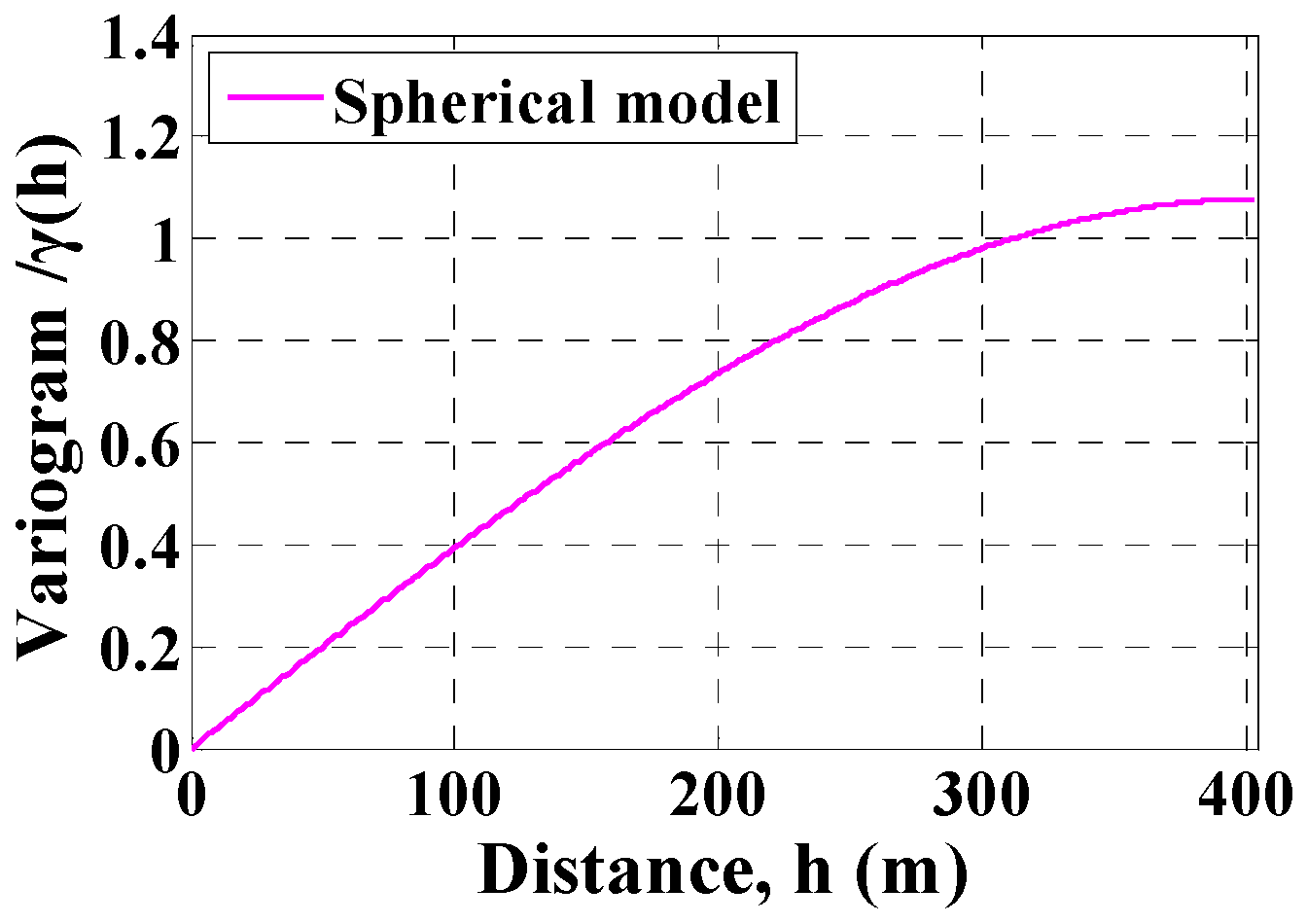
Appendix B
| Acronym | Full Name |
|---|---|
| CSR | Center for Space Research |
| DSs | Distributed scatterers |
| DInSAR | Differential Interferometric Synthetic Aperture Radar |
| ESA | European Space Agency |
| EWH | Equivalent water height |
| GLDAS | Global Land Data Assimilation System |
| GRACE | Gravity Recovery and Climate Experiment |
| GNSS | Global Navigation Satellite System |
| InSAR | Interferometric Synthetic Aperture Radar |
| ISBAS | Intermittent Small Baseline Subset |
| LOS | Line of Sight |
| Multi-temporal InSAR | Multi-temporal Interferometric Synthetic Aperture Radar |
| NASA | National Aeronautics and Space Administration |
| PS InSAR | Persistent Scatterer Interferometric Synthetic Aperture Radar |
| PSs | Point-like stable reflectors |
| QPS | Quasi Persistent Scatterer |
| RMSE | Root Mean Square Error |
| RL05 | Release 05 |
| SRTM | Shuttle Radar Topography Mission |
| SLR | Satellite Laser Ranging |
| SM | Soil Moisture |
| SBAS InSAR | Small Baseline Subset Interferometric Synthetic Aperture Radar |
| TGR | Three Gorges Reservoir |
| TWS | Terrestrial Water Storage |
References
- Luo, Q.; Perissin, D.; Lin, H.; Zhang, Y.; Wang, W. Subsidence monitoring of Tianjin suburbs by TerraSAR-X Persistent Scatterers Interferometry. IEEE J. Sel. Top. Appl. Earth Obs. Remote Sens. 2014, 7, 1642–1650. [Google Scholar] [CrossRef]
- Dong, S.; Samsonov, S.; Yin, H.; Ye, S.; Cao, Y. Time-series analysis of subsidence associated with rapid urbanization in Shanghai, China measured with SBAS InSAR method. Environ. Earth Sci. 2014, 72, 677–691. [Google Scholar] [CrossRef]
- Perissin, D.; Wang, T. Time-series InSAR applications over urban areas in China. IEEE J. Sel. Top. Appl. Earth Obs. Remote Sens. 2011, 4, 92–100. [Google Scholar] [CrossRef]
- Yang, Y.; Jia, S.M.; Wang, H.G. The status and development of land subsidence in Beijing plain. Shanghai Geol. 2010, 72, 23–28. [Google Scholar]
- Zhu, L.; Gong, H.; Li, X.; Wang, R.; Chen, B.; Dai, Z.; Teatini, P. Land subsidence due to groundwater withdrawal in the northern Beijing plain, China. Eng. Geol. 2015, 193, 243–255. [Google Scholar] [CrossRef]
- Zhang, Y.; Gong, H.; Gu, Z.; Wang, R.; Li, X.; Zhao, W.B. Characterization of land subsidence induced by groundwater withdrawals in the plain of Beijing city, China. Hydrogeol. J. 2014, 22, 397–409. [Google Scholar] [CrossRef]
- Chen, B.; Gong, H.; Li, X.; Lei, K.; Zhang, Y.; Li, J.; Gu, Z.; Dang, Y. Spatial-temporal characteristics of land subsidence corresponding to dynamic groundwater funnel in Beijing Municipality, China. Chin. Geogr. Sci. 2011, 21, 753–764. [Google Scholar] [CrossRef]
- Poland, M.; Bürgmann, R.; Dzurisin, D.; Lisowski, M.; Marsterlark, T.; Owen, S.; Fink, J. Constraints on the mechanism of long-term, steady subsidence at Medicine Lake volcano, northern California, from GPS, leveling, and InSAR. J. Volcanol. Geotherm. Res. 2006, 150, 55–78. [Google Scholar] [CrossRef]
- Amelung, F.; Galloway, D.L.; Bell, J.W.; Zebker, H.A.; Laczniak, R.J. Sensing the ups and downs of Las Vegas: InSAR reveals structural control of land subsidence and aquifer-system deformation. Geology 1999, 27, 483–486. [Google Scholar] [CrossRef]
- Motagh, M.; Walter, T.R.; Sharifi, M.A.; Fielding, E.; Schenk, A.; Anderssohn, J.; Zschau, J. Land subsidence in Iran caused by widespread water reservoir overexploitation. Geophys. Res. Lett. 2008, 35, L16403. [Google Scholar] [CrossRef]
- Chaussard, E.; Amelung, F.; Abidin, H.; Hong, S.H. Sinking cities in Indonesia: ALOS PALSAR detects rapid subsidence due to groundwater and gas extraction. Remote Sens. Environ. 2013, 128, 150–161. [Google Scholar] [CrossRef]
- Gabriel, A.K.; Goldstein, R.M.; Zebker, H.A. Mapping small elevation changes over large areas: Differential radar interferometry. J. Geophys. Res. 1989, 94, 9183–9191. [Google Scholar] [CrossRef]
- Pathier, E.; Fielding, E.J.; Wright, T.J.; Walker, R.; Parsons, B.E.; Hensley, S. Displacement field and slip distribution of the 2005 Kashmir earthquake from SAR imagery. Geophys. Res. Lett. 2006, 33, 382–385. [Google Scholar] [CrossRef]
- Li, Z.; Elliott, J.R.; Feng, W.; Jackson, J.A.; Parsons, B.E.; Walters, R.J. The 2010 M W 6.8 Yushu (Qinghai, China) earthquake: constraints provided by InSAR and body wave seismology. J. Geophys. Res.: Atmos. 2011, 116, 381–386. [Google Scholar] [CrossRef]
- Schlögel, R.; Doubre, C.; Malet, J.P.; Masson, F. Landslide deformation monitoring with ALOS/PALSAR imagery: A D-InSAR geomorphological interpretation method. Geomorphology 2015, 231, 314–330. [Google Scholar] [CrossRef]
- Zhao, C.; Lu, Z.; Zhang, Q.; Fuente, J. Large-area landslide detection and monitoring with ALOS/PALSAR imagery data over Northern California and Southern Oregon, USA. Remote Sens. Environ. 2012, 124, 348–359. [Google Scholar] [CrossRef]
- Raucoules, D.; Le Mouelic, S.; Carnec, C.; Maisons, C.; King, C. Urban subsidence in the city of Prato (Italy) monitored by satellite radar interferometry. Int. J. Remote Sens. 2003, 24, 891–897. [Google Scholar] [CrossRef]
- Necsoiu, M.; Hooper, D.M. Use of Emerging InSAR and LiDAR Remote Sensing Technologies to Anticipate and Monitor Critical Natural Hazards. In Building Safer Communities. Risk Governance, Spatial Planning and Responses to Natural Hazards; Fra Paleo, U., Ed.; IOS Press: Amsterdam, The Netherlands, 2009; Volume 58, pp. 246–267. [Google Scholar]
- Ferretti, A.; Prati, C.; Rocca, F. Permanent scatterers in SAR interferometry. IEEE Trans. Geosci. Remote Sens. 2001, 39, 8–20. [Google Scholar] [CrossRef]
- Ferretti, A.; Savio, G.; Barzaghi, R.; Borghi, A.; Musazzi, S.; Novali, F.; Prati, C.; Rocca, F. Submillimeter accuracy of InSAR time series: Experimental validation. IEEE Trans. Geosci. Remote Sens. 2007, 45, 1142–1153. [Google Scholar] [CrossRef]
- Beradino, P.; Fornaro, G.; Lanari, R.; Sansosti, E. A new algorithm for Surface deformation monitoring based on small baseline differential SAR interferograms. IEEE Trans. Geosci. Remote Sens. 2002, 40, 2375–2383. [Google Scholar] [CrossRef]
- Lanari, R.; Mora, O.; Manunta, M.; Mallorquí, J.J.; Beradino, P.; Sansosti, E. A small-baseline approach for investigating deformations on full-resolution differential SAR interferograms. IEEE Trans. Geosci. Remote Sens. 2004, 42, 1377–1386. [Google Scholar] [CrossRef]
- Sowter, A.; Bateson, L.; Strange, P.; Ambrose, K.; Syafiudin, M. DInSAR estimation of land motion using intermittent coherence with application to the South Derbyshire and Leicestershire coalfield. Remote Sens. Lett. 2013, 4, 979–987. [Google Scholar] [CrossRef]
- Bateson, L.; Cigna, F.; Boon, D.; Sowter, A. The application of the Intermittent SBAS (ISBAS) InSAR method to the South Wales Coalfield, UK. Int. J. Appl. Earth Obs. Geoinform. 2015, 34, 249–257. [Google Scholar] [CrossRef]
- Vajedian, S.; Motagh, M.; Nilfouroushan, F. StaMPS improvement for deformation analysis in mountainous regions: Implications for the Damavand volcano and Mosha fault in Alborz. Remote Sens. 2015, 7, 8323–8347. [Google Scholar] [CrossRef]
- Perissin, D.; Wang, T. Repeat-pass SAR interferometry with partially coherent targets. IEEE Trans. Geosci. Remote Sens. 2012, 50, 271–280. [Google Scholar] [CrossRef]
- Zhang, L.; Ding, X.; Lu, Z. Modeling PSInSAR time series without phase unwrapping. IEEE Trans. Geosci. Remote Sens. 2011, 49, 547–556. [Google Scholar] [CrossRef]
- Hooper, A. A multi-temporal InSAR method incorporating both persistent scatterer and small baseline approaches. Geophys. Res. Lett. 2008, 30, L16302. [Google Scholar] [CrossRef]
- Tang, P.; Chen, F.L.; Guo, H.D.; Tian, B.; Wang, X.; Ishwaran, N. Large-Area Landslides Monitoring Using Advanced Multi-Temporal InSAR Technique over the Giant Panda Habitat, Sichuan, China. Remote Sens. 2015, 7, 8925–8949. [Google Scholar] [CrossRef]
- Hay-Man Ng, A.; Ge, L.L.; Li, X.; Zhang, K. Monitoring ground deformation in Beijing, China with persistent scatterer SAR interferometry. J. Geod. 2012, 86, 375–392. [Google Scholar]
- Hu, B.; Wang, H.; Sun, Y.; Hou, J.; Liang, J. Land-term land subsidence monitoring of Beijing (China) using the Small Baseline Subset (SBAS) technique. Remote Sens. 2014, 6, 3648–3661. [Google Scholar] [CrossRef]
- Chen, M.; Tomás, R.; Li, Z.; Motagh, M.; Li, T.; Hu, L.; Gong, H.; Li, X.; Yu, J.; Gong, X. Imaging Land Subsidence Induced by Groundwater Extraction in Beijing (China) Using Satellite Radar Interferometry. Remote Sens. 2016, 8, 468. [Google Scholar] [CrossRef]
- Wang, X.; Linage, C.; Famiglietti, J.; Zender, C. Gravity Recovery and Climate Experiment (GRACE) detection of water storage changes in the Three Gorges Reservoir of China and comparison with in situ measurements. Water Resour. Res. 2011, 47, 1091–1096. [Google Scholar] [CrossRef]
- Zhou, Y.; Jin, S.; Tenzer, R.; Feng, J. Water storage variations in the Poyanghu Basin estimated from GRACE and satellite altimetry. Geod. Geodyn. 2016. [Google Scholar] [CrossRef]
- Henry, C.M.; Allen, D.M.; Huang, J. Groundwater storage variability and annual recharge using well-hydrograph and GRACE satellite data. Hydrogeol. J. 2011, 19, 741–755. [Google Scholar] [CrossRef]
- Famiglietti, J.; Lo, M.; Ho, S.; Bethune, J.; Anderson, K.; Syed, T.; Swenson, S.; de Linage, C.; Rodell, M. Satellites measure recent rates of groundwater depletion in California’s Central Valley. Geophys. Res. Lett. 2011, 38, L03403. [Google Scholar] [CrossRef]
- Scanlon, B.R.; Longuevergne, L.; Long, D. Ground referencing GRACE satellite estimates of groundwater storage changes in the California Central Valley, USA. Water Resour. Res. 2012, 48, W04520. [Google Scholar] [CrossRef]
- Huang, Z.; Pan, Y.; Gong, H.; Yeh, P.J.-F.; Li, X.; Zhou, D.; Zhao, W. Subregional-scale groundwater depletion detected by GRACE for both shallow and deep aquifers in North China Plain. Geophys. Res. Lett. 2015, 42, 1791–1799. [Google Scholar] [CrossRef]
- Liu, R.; Li, J.C.; Fok, H.S.; Shum, C.K.; Li, Z. Earth surface deformation in the North China Plain detected by joint analysis of GRACE and GPS data. Sensors 2014, 14, 19861–19876. [Google Scholar] [CrossRef] [PubMed]
- Beijing Bureau of Geology and Mineral Resources Exploration and Development; Beijing Institution of Hydrogeology and Engineering Geology. Beijing Groundwater, 1st ed.; China Land Press: Beijing, China, 2008. [Google Scholar]
- Yang, Z.; Dou, Y.; Wang, Z. Analysis on the reasons of the decline of ground water level in the primary water supply source area of Beijing and the counter measures. China Water Resour. 2010, 60, 51–54. [Google Scholar]
- Rodell, M.; Houser, P.R.; Jambor, U.; Gottschalck, J.; Mitchell, K.; Meng, C.J.; Arsenault, K.; Cosgrove, B.; Radakovich, J.; Bosilovich, M.; et al. The global land data assimilation system. Bull. Am. Meteorol. Soc. 2004, 85, 381–394. [Google Scholar] [CrossRef]
- Hooper, A.; Segall, P.; Zebker, H. Persistent scatterer interferometric synthetic aperture radar for crustal deformation analysis, with application to Volcán Alcedo, Galápagos. J. Geophys. Res.: Atmos. 2007, 112, B07407. [Google Scholar] [CrossRef]
- Wahr, J.; Molenaar, M.; Bryan, F. Time variability of the Earth’s gravity field: Hydrological and oceanic effects and their possible detection using GRACE. J. Geophys. Res. Solid Earth 1998, 103, 30205–30229. [Google Scholar] [CrossRef]
- Kuo, C.Y.; Shum, C.K.; Guo, J.Y.; Yi, Y.C.; Braun, A.; Fukumori, I.; Matsumoto, K.; Sato, T.; Shibuya, K. Southern ocean mass variation studies using GRACE and satellite altimetry. Earth Planets Space 2008, 60, 477–485. [Google Scholar] [CrossRef]
- Pan, Y.J.; Shen, W.B.; Hwang, C.; Liao, C.; Zhang, T.; Zhang, G. Seasonal Mass Changes and Crustal Vertical Deformations Constrained by GPS and GRACE in Northeastern Tibet. Sensors 2016, 16, 1211. [Google Scholar] [CrossRef] [PubMed]
- Luo, Z.C.; Li, Q.; Zhang, K.; Wang, H.H. Trend of mass change in the Antarctic ice sheet recovered from the GRACE temporal gravity field. Sci. China: Earth Sci. 2012, 55, 76–82. [Google Scholar] [CrossRef]
- Chen, J.L.; Rodell, M.; Wilson, C.R.; Famiglietti, J.S. Low degree spherical harmonic influences on Gravity Recovery and Climate Experiment (GRACE) water storage estimates. Geophys. Res. Lett. 2005, 32, 57–76. [Google Scholar] [CrossRef]
- Swenson, S.; Wahr, J. Post-processing removal of correlated errors in GRACE data. Geophys. Res. Lett. 2006, 33, L08402. [Google Scholar] [CrossRef]
- Zhang, Z.; Chao, B.F.; Yang, L.; Hsu, H.T. An effective filtering for GRACE time-variable gravity: Fan filter. Geophys. Res. Lett. 2009, 36, 1397–1413. [Google Scholar] [CrossRef]
- Li, Q.; Luo, Z.C.; Zhong, B. Terrestrial water storage changes of the 2010 Southwest China drought detected by GRACE temporal gravity field. Chin. J. Geophys. 2013, 56, 1843–1849. [Google Scholar]
- Kusche, J. Approximate decorrelation and non-isotropic smoothing of time-variable GRACE-type gravity field models. J. Geod. 2007, 81, 733–749. [Google Scholar] [CrossRef]
- Strassberg, G.; Scanlon, B.R.; Chambers, D. Evaluation of groundwater storage monitoring with the GRACE satellite: Case study of the High Plains aquifer, central United States. Water Resour. Res. 2009, 45, 195–211. [Google Scholar] [CrossRef]
- Feng, W.; Zhong, M.; Lemoine, J.M.; Biancale, R.; Hsu, H.T.; Xia, J. Evaluation of groundwater depletion in North China using the Gravity Recovery and Climate Experiment (GRACE) data and ground-based measurements. Water Resour. Res. 2013, 49, 2110–2118. [Google Scholar] [CrossRef]
- Zhou, Y.; Dong, D.; Liu, J.; Li, W. Upgrading a regional groundwater level monitoring network for Beijing Plain, China. Geosci. Front. 2013, 4, 127–138. [Google Scholar] [CrossRef]
- Sun, F.; Shao, H.; Kalbacher, T.; Wang, W.; Yang, Z.; Huang, Z.; Kolditz, O. Groundwater drawdown at Nankou site of Beijing Plain: Model development and calibration. Environ. Earth Sci. 2011, 64, 1323–1333. [Google Scholar] [CrossRef]
- Li, Y.S.; Zhang, J.F.; Li, Z.H.; Luo, Y. Land subsidence in Beijing City from InSAR time series analysis with small baseline subset. Geomatics Inf. Sci. Wuhan Univ. 2013, 38, 1374–1377. [Google Scholar]
- Jiang, Y.; Yang, Y.; Wang, H.G.; Tian, F. Factors controlling land subsidence on the Beijing plain. Shanghai Land Resour. 2014, 35, 130–133. [Google Scholar]
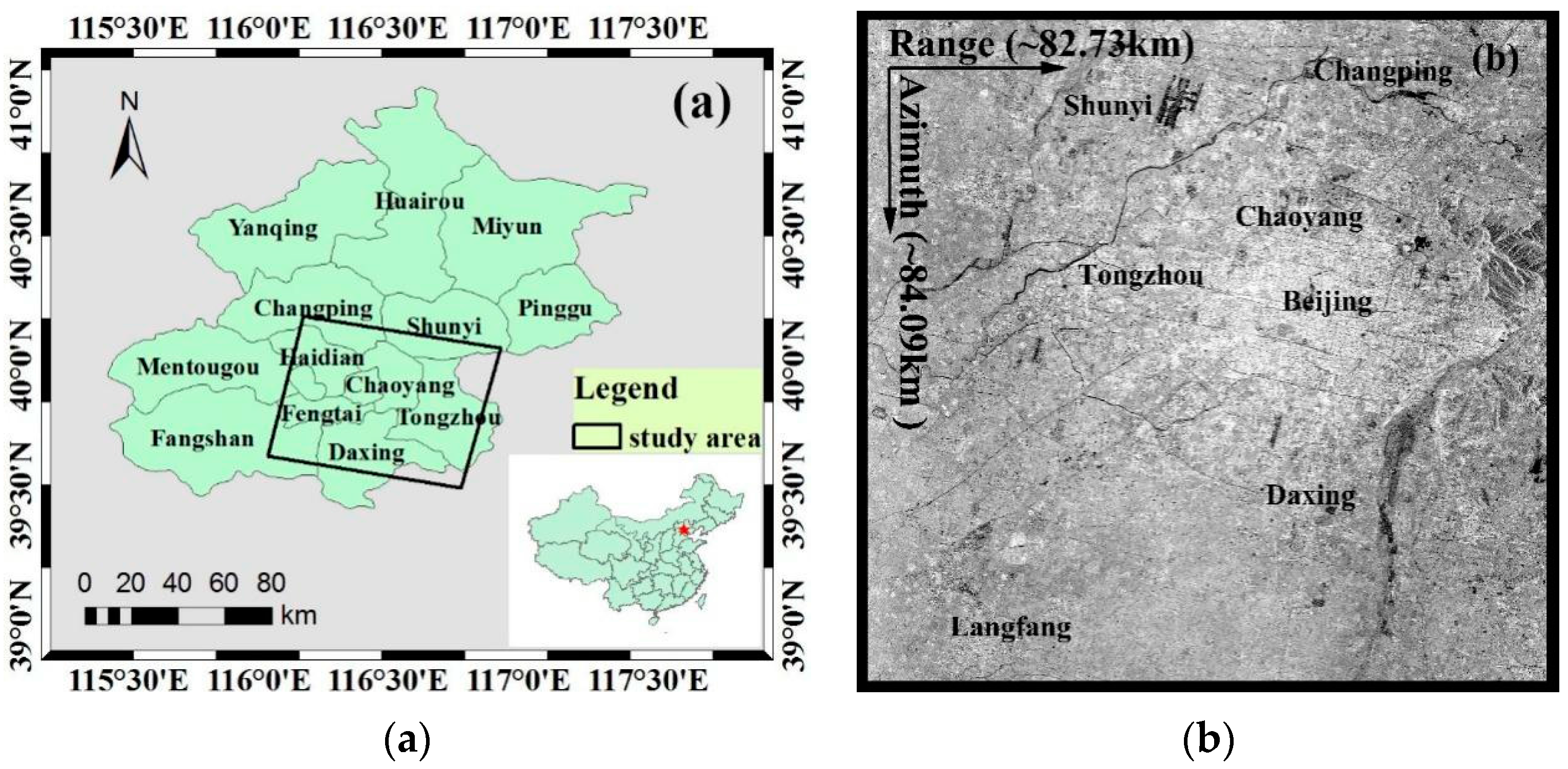
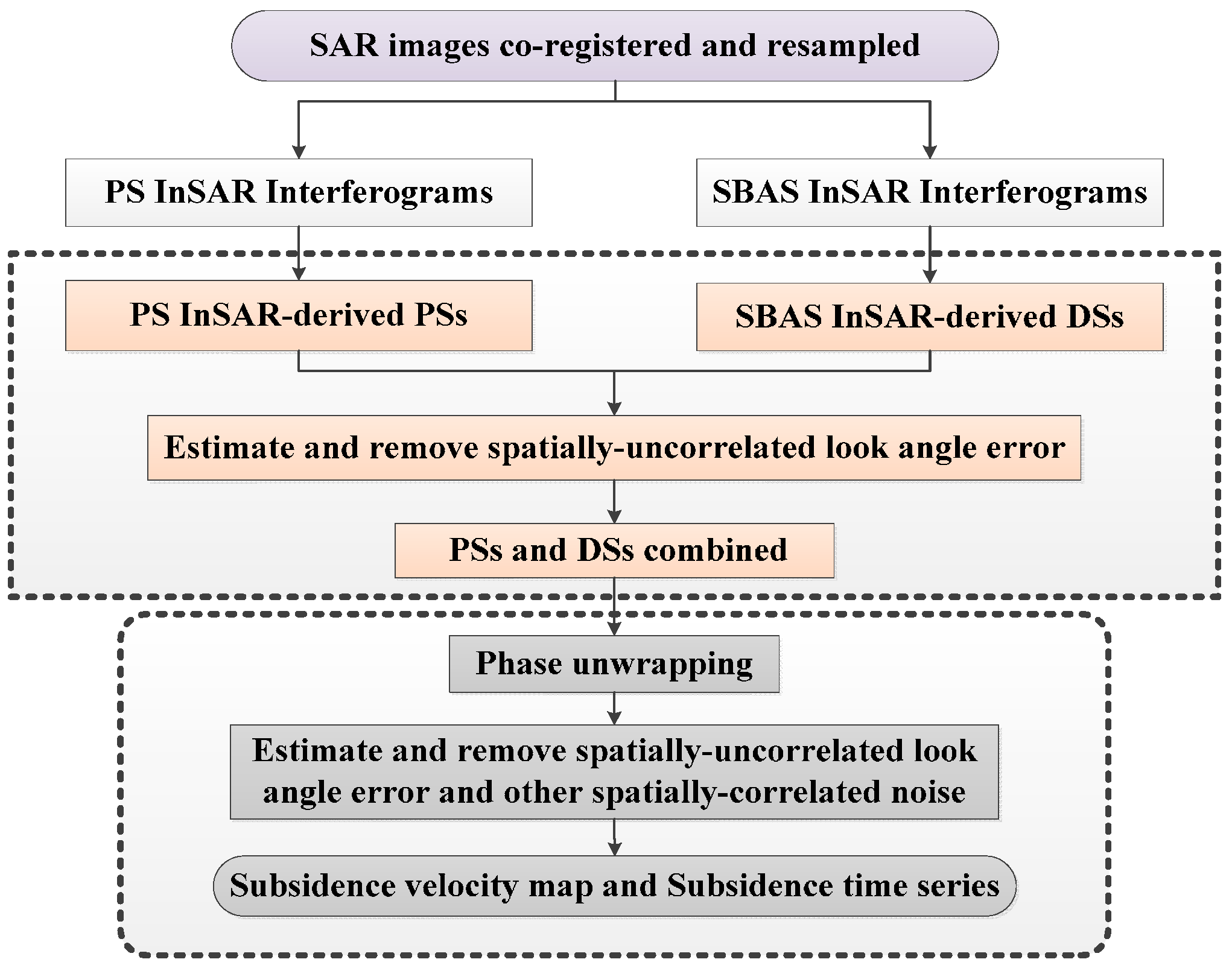
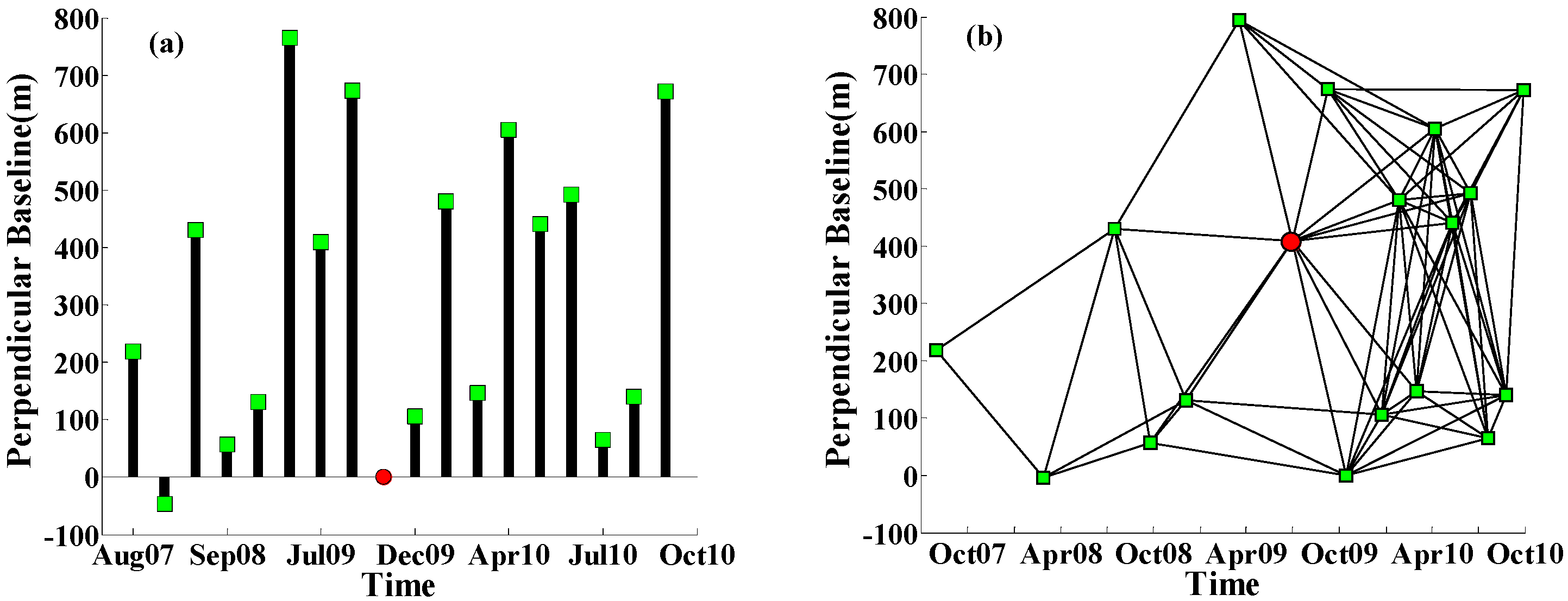
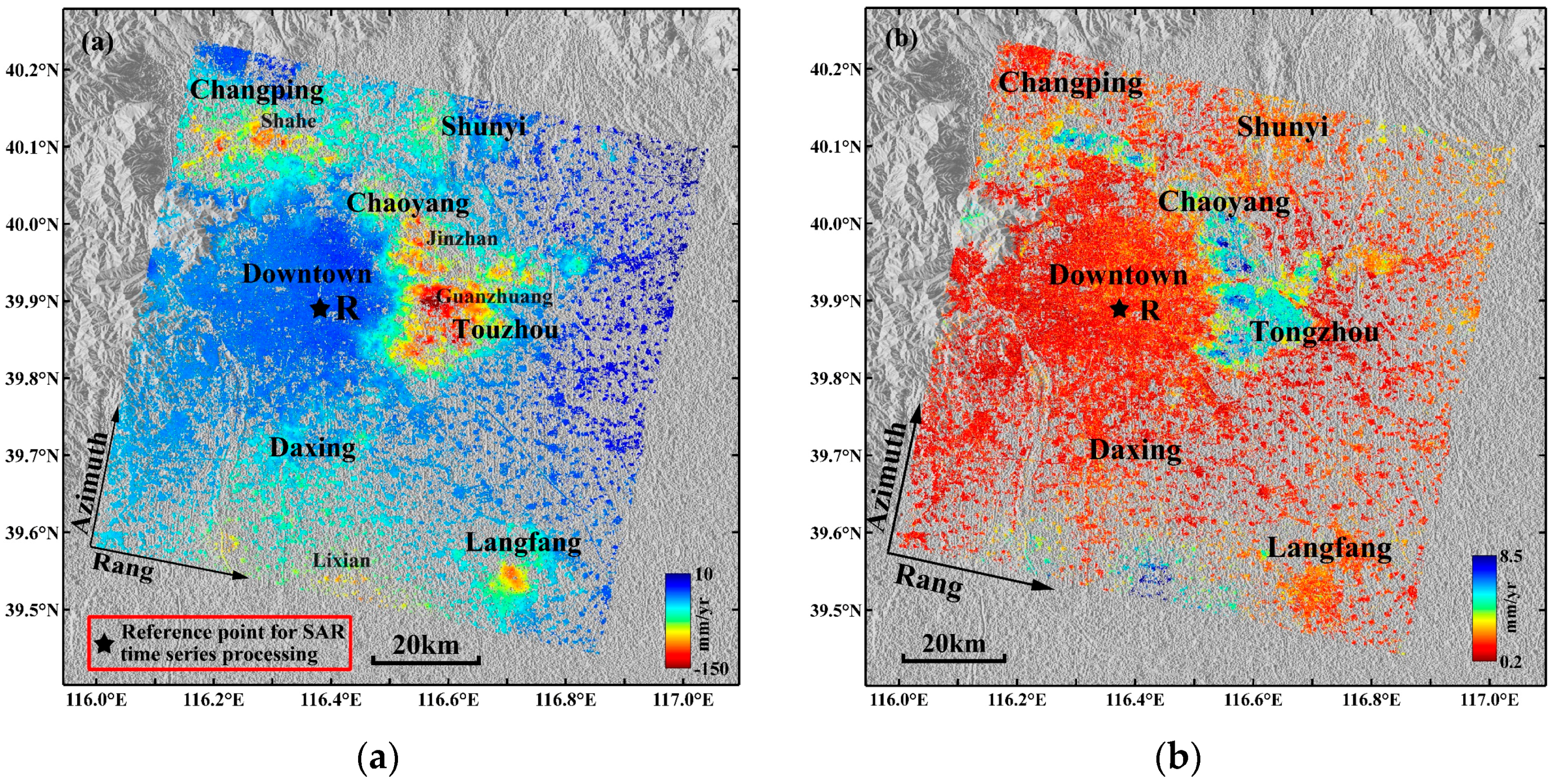
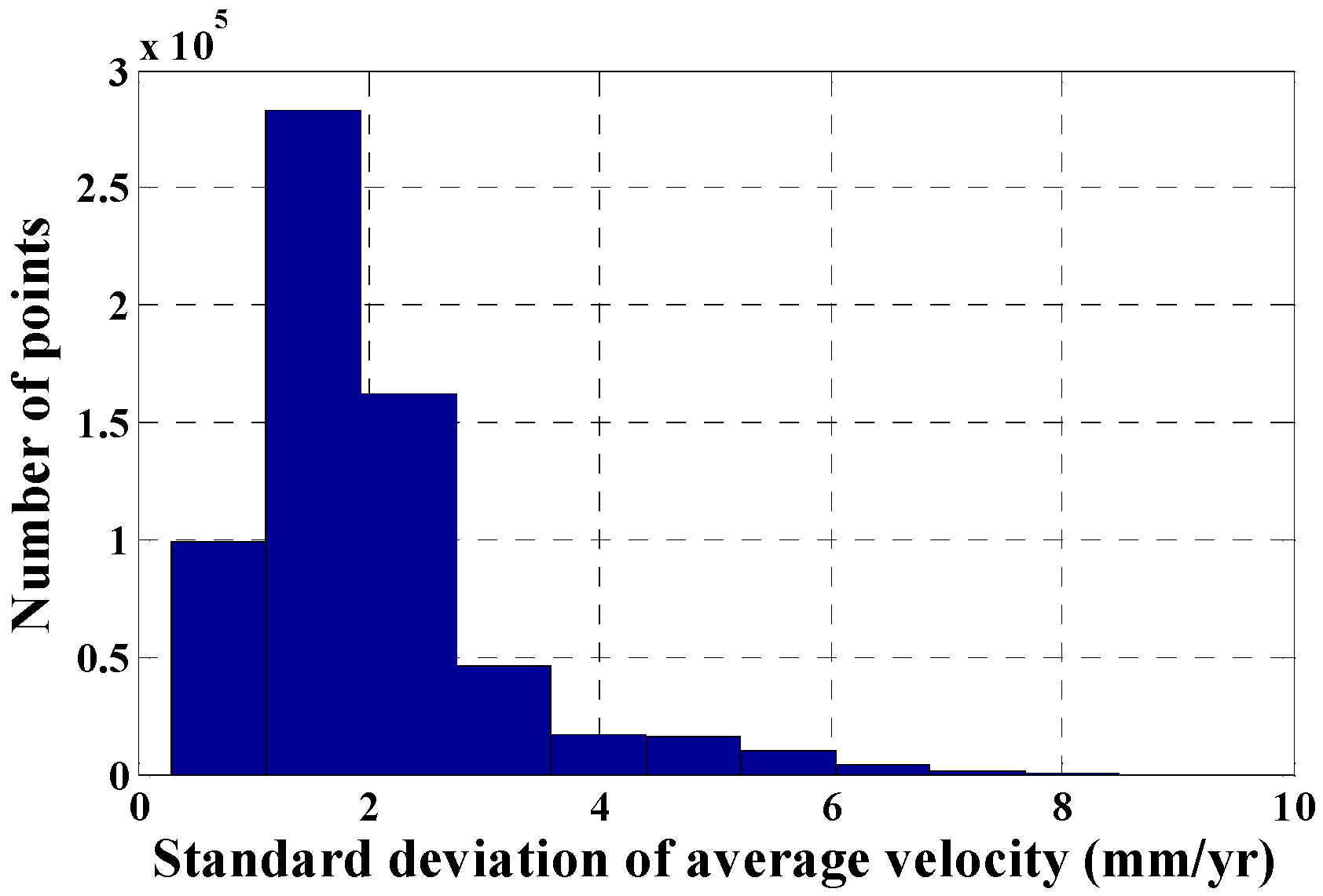
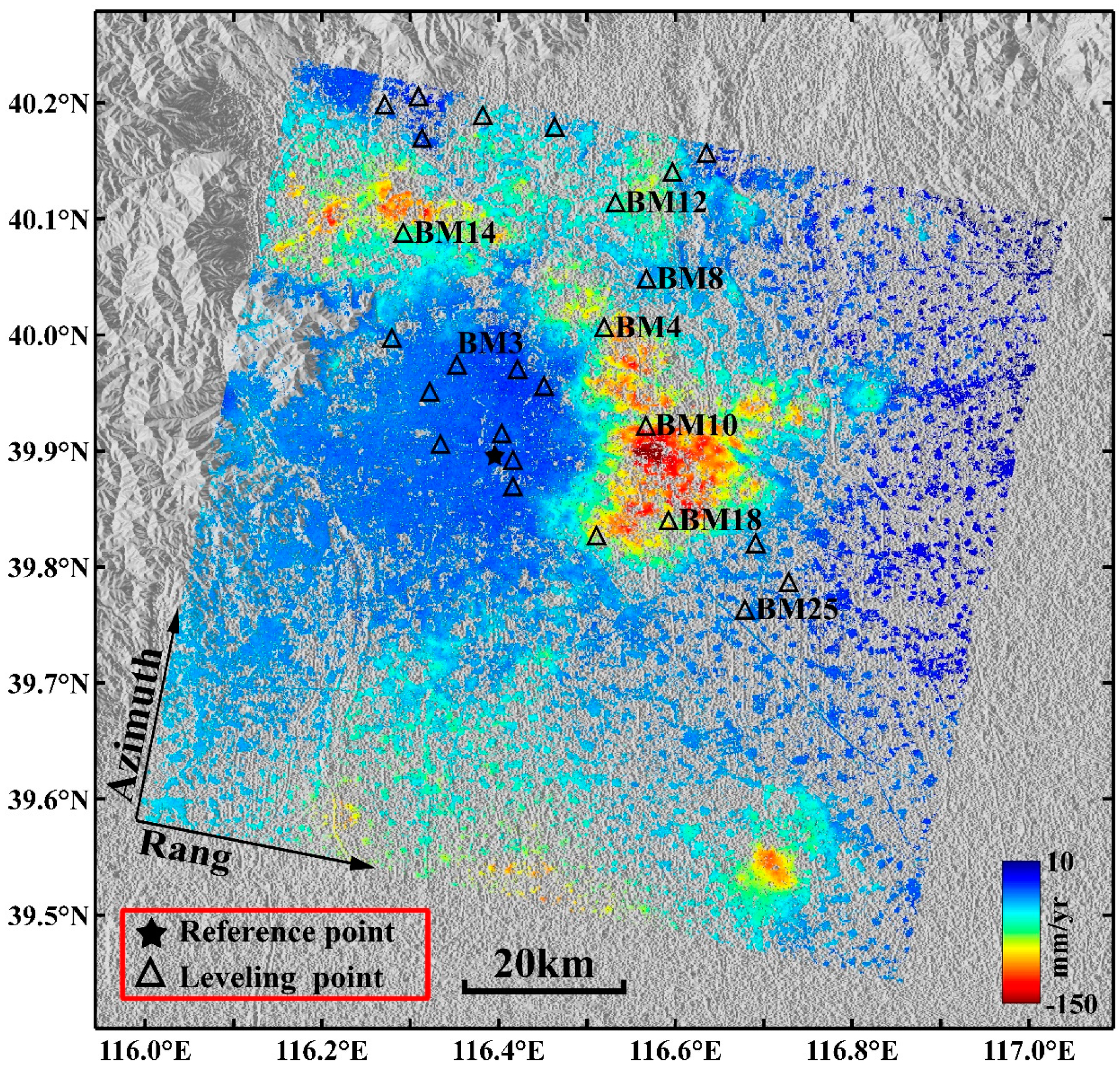
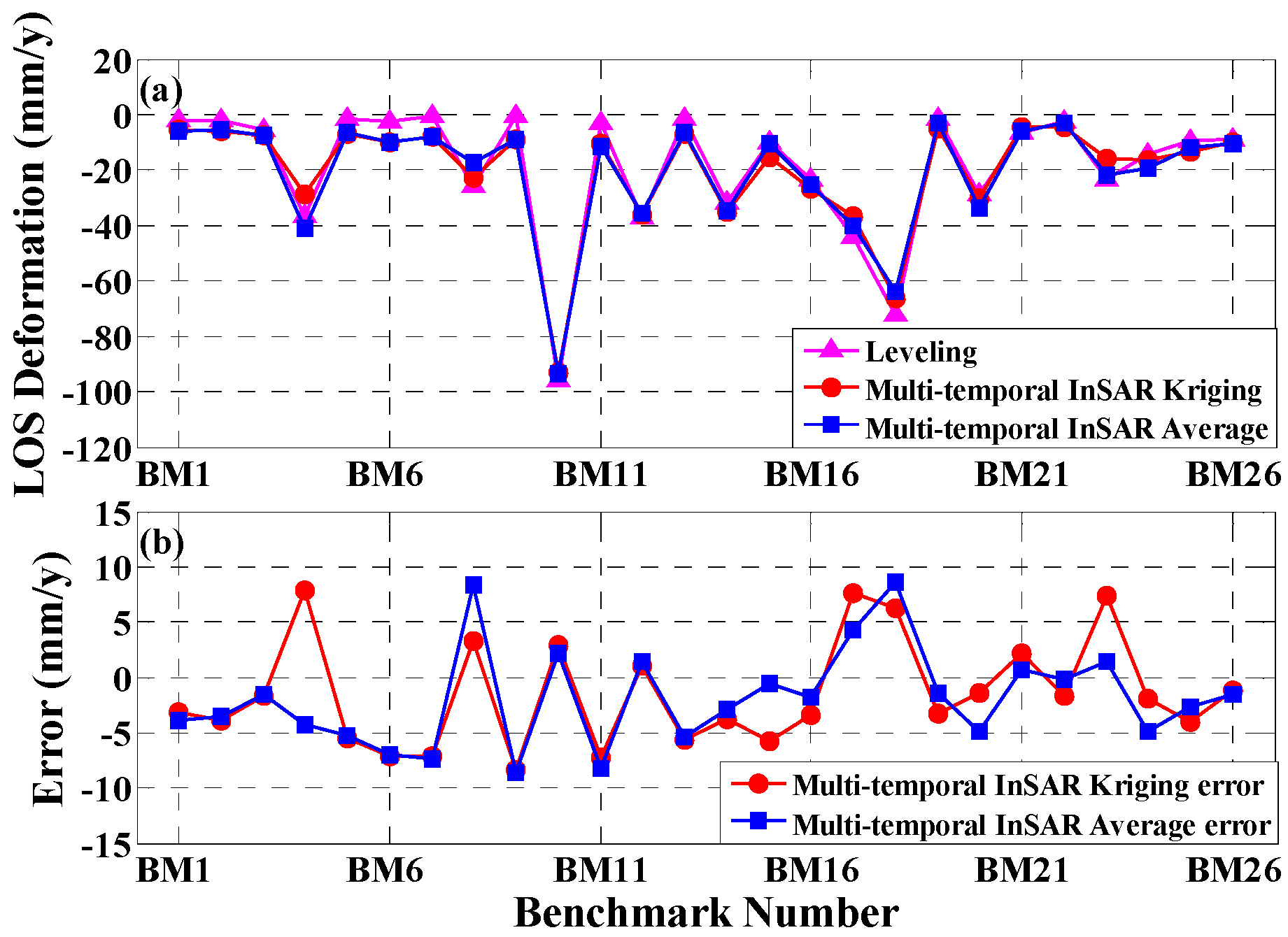
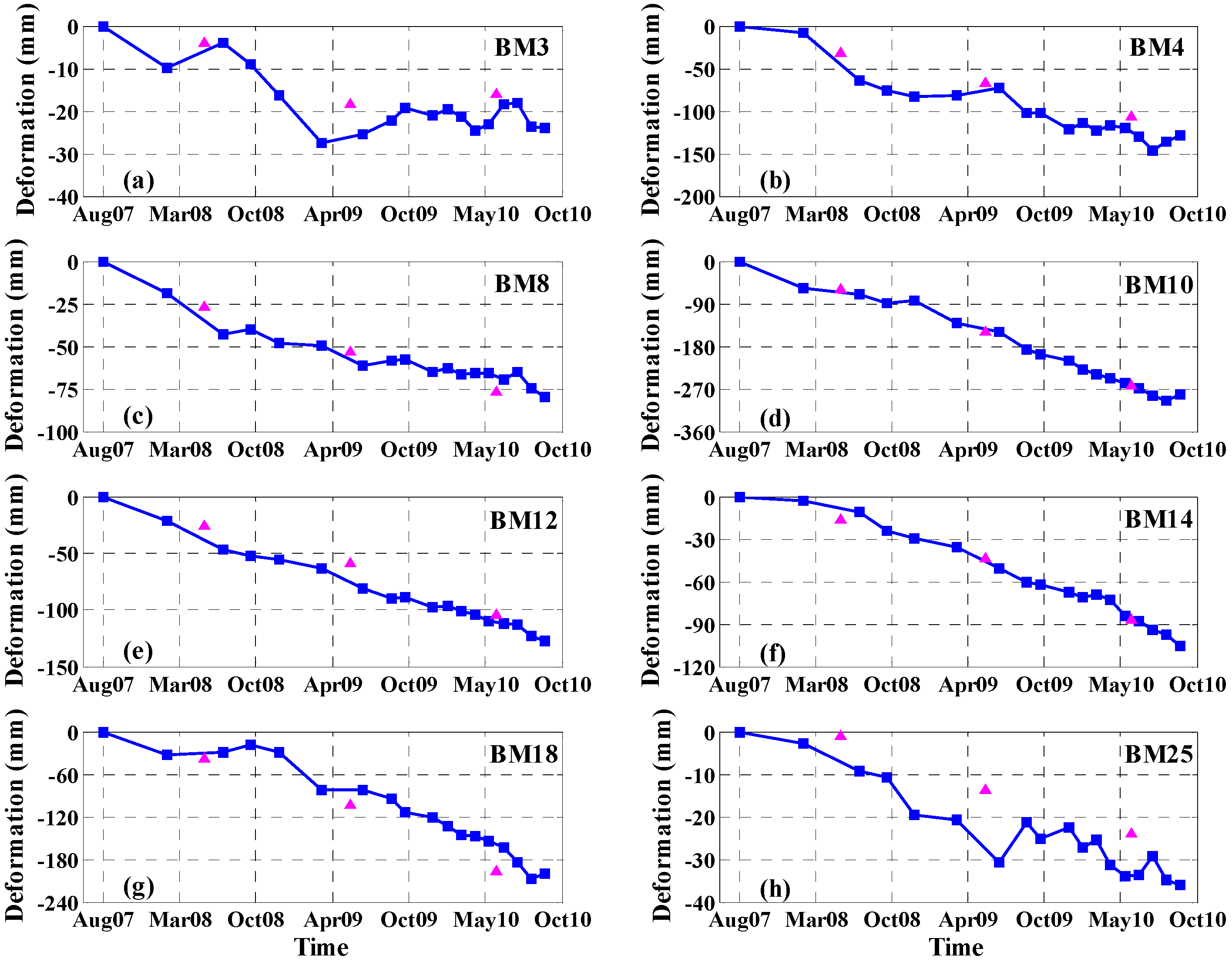
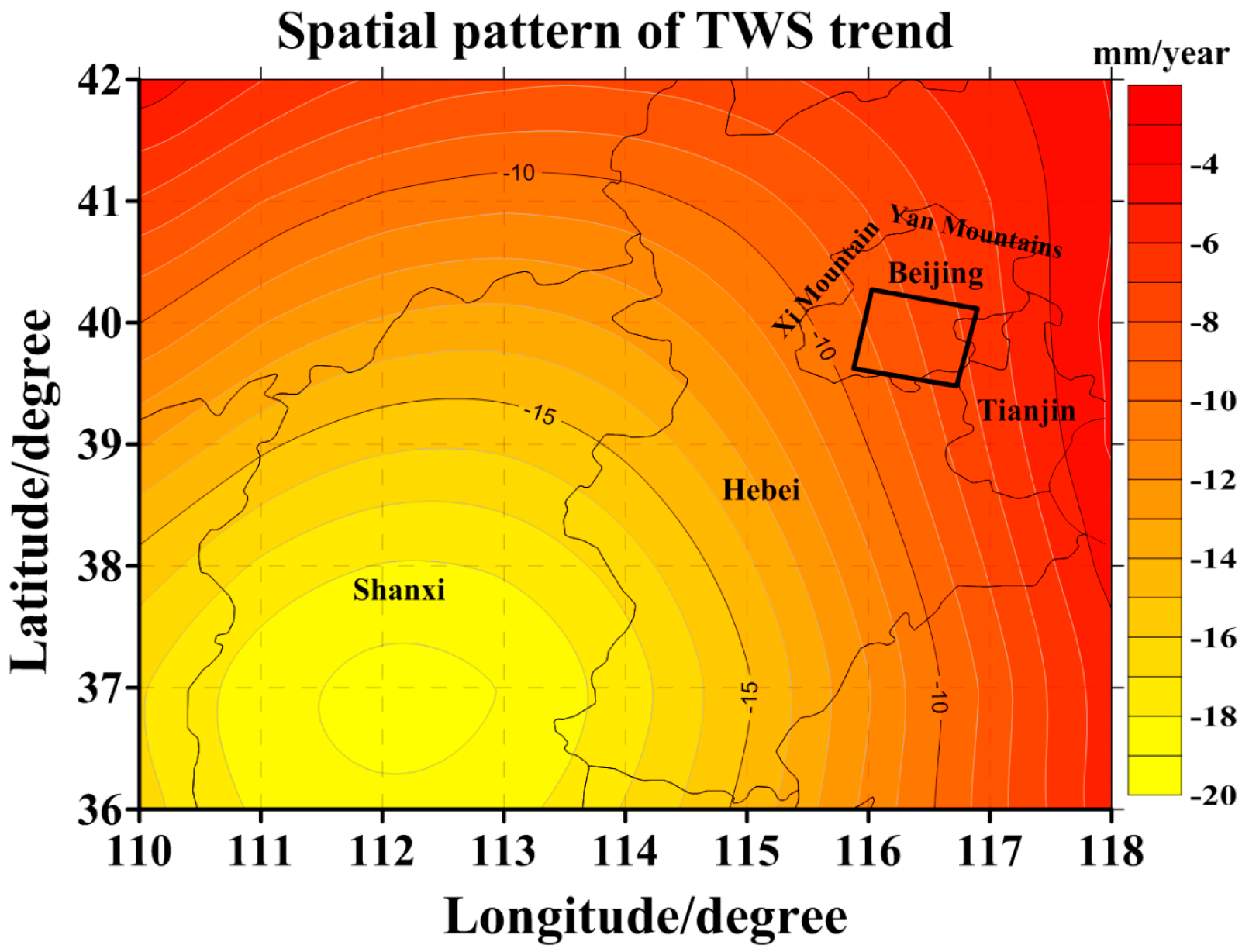
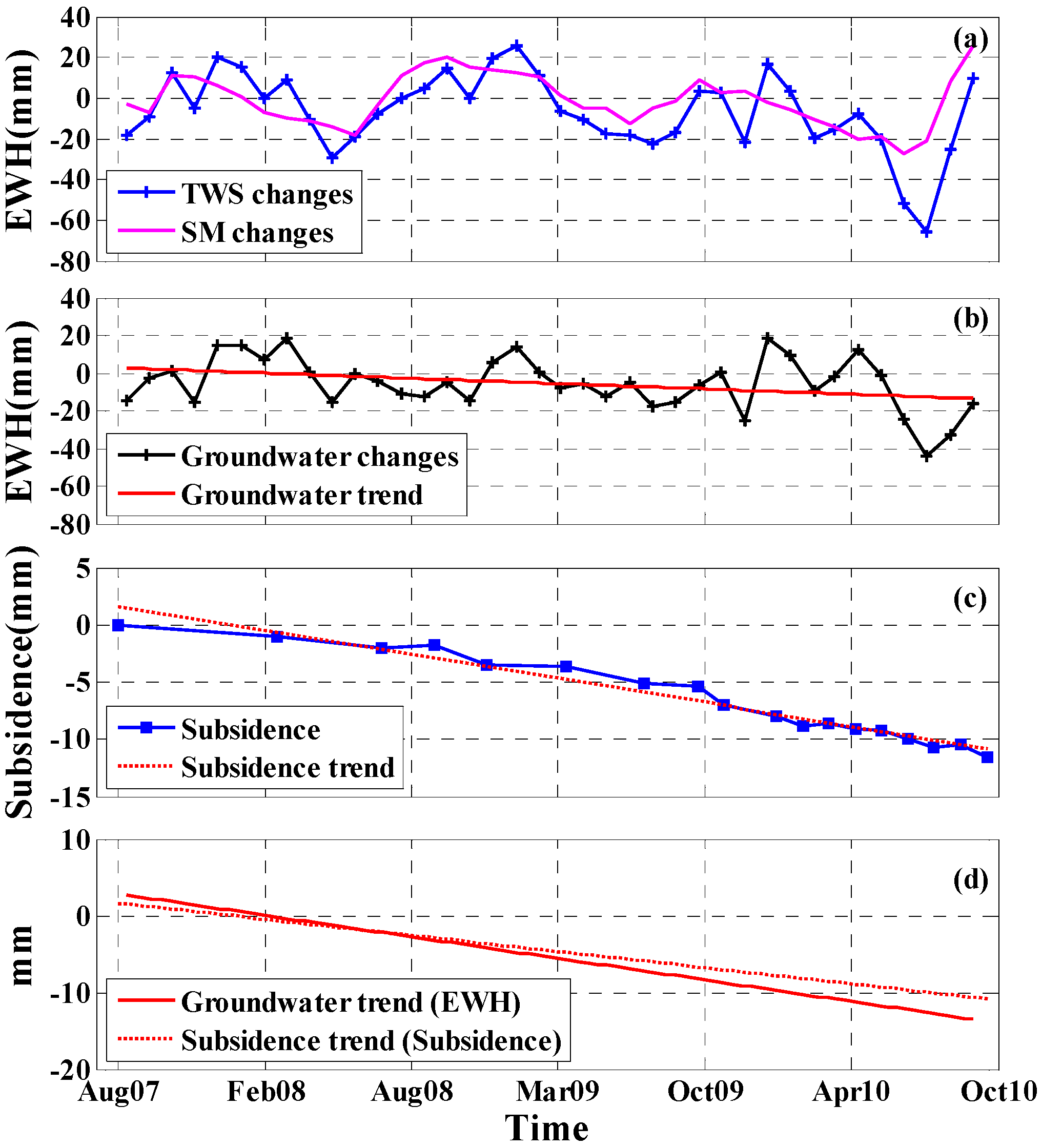
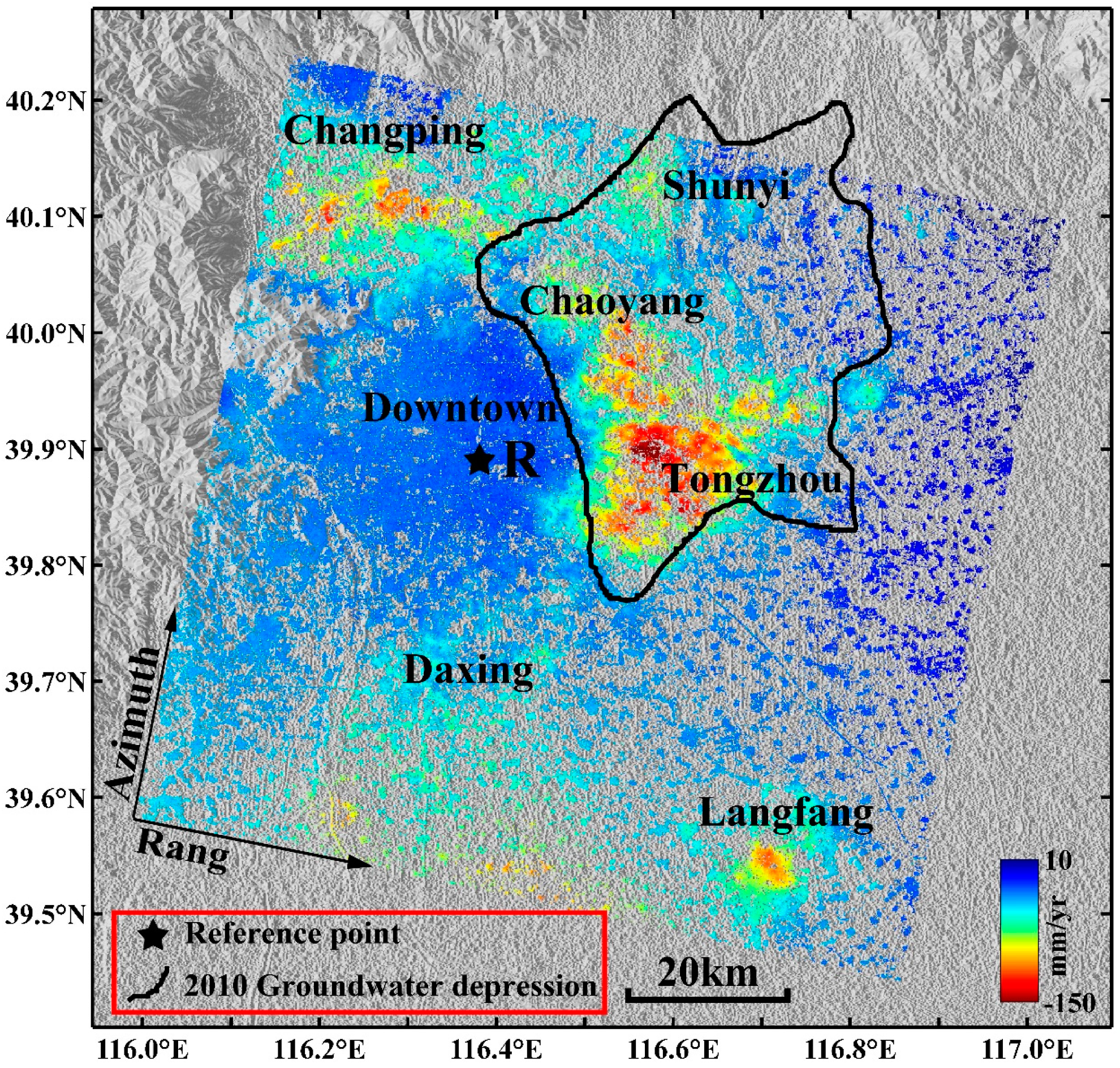
| Method | Mean Error (mm/year) | RMSE (mm/year) | MAX (mm/year) | MIN (mm/year) |
|---|---|---|---|---|
| Kriging | 1.44 | 4.97 | 8.33 | 1.01 |
| Average | 1.90 | 4.78 | 8.60 | 0.18 |
© 2016 by the authors; licensee MDPI, Basel, Switzerland. This article is an open access article distributed under the terms and conditions of the Creative Commons Attribution (CC-BY) license (http://creativecommons.org/licenses/by/4.0/).
Share and Cite
Guo, J.; Zhou, L.; Yao, C.; Hu, J. Surface Subsidence Analysis by Multi-Temporal InSAR and GRACE: A Case Study in Beijing. Sensors 2016, 16, 1495. https://doi.org/10.3390/s16091495
Guo J, Zhou L, Yao C, Hu J. Surface Subsidence Analysis by Multi-Temporal InSAR and GRACE: A Case Study in Beijing. Sensors. 2016; 16(9):1495. https://doi.org/10.3390/s16091495
Chicago/Turabian StyleGuo, Jiming, Lv Zhou, Chaolong Yao, and Jiyuan Hu. 2016. "Surface Subsidence Analysis by Multi-Temporal InSAR and GRACE: A Case Study in Beijing" Sensors 16, no. 9: 1495. https://doi.org/10.3390/s16091495






